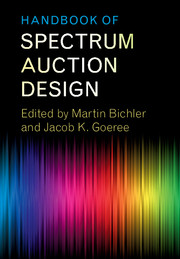Book contents
- Frontmatter
- Contents
- List of Contributors
- Preface
- List of Papers
- Part I The Simultaneous Multiple-Round Auction
- Part II The Combinatorial Clock Auction Designs
- 5 Combinatorial Auction Design
- 6 The Clock-Proxy Auction: A Practical Combinatorial Auction Design
- 7 Spectrum Auction Design
- 8 A Practical Guide to the Combinatorial Clock Auction
- 9 Market Design and the Evolution of the Combinatorial Clock Auction
- 10 Quadratic Core-Selecting Payment Rules for Combinatorial Auctions
- 11 Core-Selecting Package Auctions
- 12 A New Payment Rule for Core-Selecting Package Auctions
- 13 On the Impossibility of Core-Selecting Auctions
- 14 Ascending Combinatorial Auctions with Risk Averse Bidders
- 15 Properties of the Combinatorial Clock Auction
- 16 Budget Constraints in Combinatorial Clock Auctions
- 17 (Un)expected Bidder Behavior in Spectrum Auctions: About Inconsistent Bidding and its Impact on Efficiency in the Combinatorial Clock Auction
- Part III Alternative Auction Designs
- Part IV Experimental Comparisons of Auction Designs
- Part V The Bidders’ Perspective
- Part VI Secondary Markets and Exchanges
- Outlook
- References
14 - Ascending Combinatorial Auctions with Risk Averse Bidders
from Part II - The Combinatorial Clock Auction Designs
Published online by Cambridge University Press: 26 October 2017
- Frontmatter
- Contents
- List of Contributors
- Preface
- List of Papers
- Part I The Simultaneous Multiple-Round Auction
- Part II The Combinatorial Clock Auction Designs
- 5 Combinatorial Auction Design
- 6 The Clock-Proxy Auction: A Practical Combinatorial Auction Design
- 7 Spectrum Auction Design
- 8 A Practical Guide to the Combinatorial Clock Auction
- 9 Market Design and the Evolution of the Combinatorial Clock Auction
- 10 Quadratic Core-Selecting Payment Rules for Combinatorial Auctions
- 11 Core-Selecting Package Auctions
- 12 A New Payment Rule for Core-Selecting Package Auctions
- 13 On the Impossibility of Core-Selecting Auctions
- 14 Ascending Combinatorial Auctions with Risk Averse Bidders
- 15 Properties of the Combinatorial Clock Auction
- 16 Budget Constraints in Combinatorial Clock Auctions
- 17 (Un)expected Bidder Behavior in Spectrum Auctions: About Inconsistent Bidding and its Impact on Efficiency in the Combinatorial Clock Auction
- Part III Alternative Auction Designs
- Part IV Experimental Comparisons of Auction Designs
- Part V The Bidders’ Perspective
- Part VI Secondary Markets and Exchanges
- Outlook
- References
Summary
Introduction
The need to buy or sell multiple objects arises in areas such as industrial procurement, logistics, or when governments allocate spectrum licenses or other assets. It is a fundamental topic and the question how multiple indivisible objects should be allocated via an auction has enjoyed renewed interest in recent years (Airiau and Sen 2003; Cramton et al. 2006; Day and Raghavan 2007; Xia et al. 2004). One of the key goals in this research literature is to develop mechanisms that achieve high (allocative) efficiency with a strong game-theoretical solution concept such as a dominant strategy or an ex-post Nash strategy, such that bidders have no incentive to misrepresent their valuations. In other words, the strategic complexity for bidders is low as they do not need prior information about other bidders’ valuations. Allocative efficiency measures whether the auctioned objects finally end up with the bidders who value them the most, thus, representing a measure of social welfare.
Combinatorial auctions are the most general types of multi-object market mechanisms, as they allow selling or buying a set of heterogeneous items to or from multiple bidders (Cramton et al. 2006). Bidders can specify package (or bundle) bids, i.e., prices are defined for the subsets of items that are auctioned. The price is only valid for the entire bundle, and the bid is indivisible. For example, in a combinatorial auction a bidder might want to buy a bundle, consisting of item x and item y, for a bundle price of $100, which might be more than the sum of the item prices for x and y, when sold individually. We will say that bidder valuations for both items are complementary in this case.
Many publications have focused on the computational complexity of the allocation problem in combinatorial auctions (Lehmann et al. 2006; Rothkopf et al. 1998). Computational complexity is often manageable in real-world applications with a low number of items and bidders.
- Type
- Chapter
- Information
- Handbook of Spectrum Auction Design , pp. 264 - 293Publisher: Cambridge University PressPrint publication year: 2017



